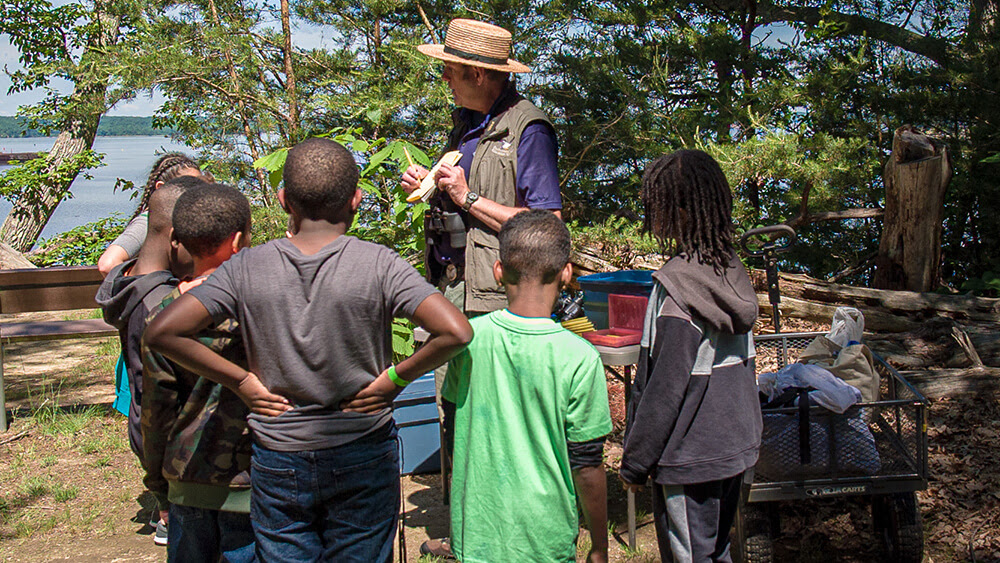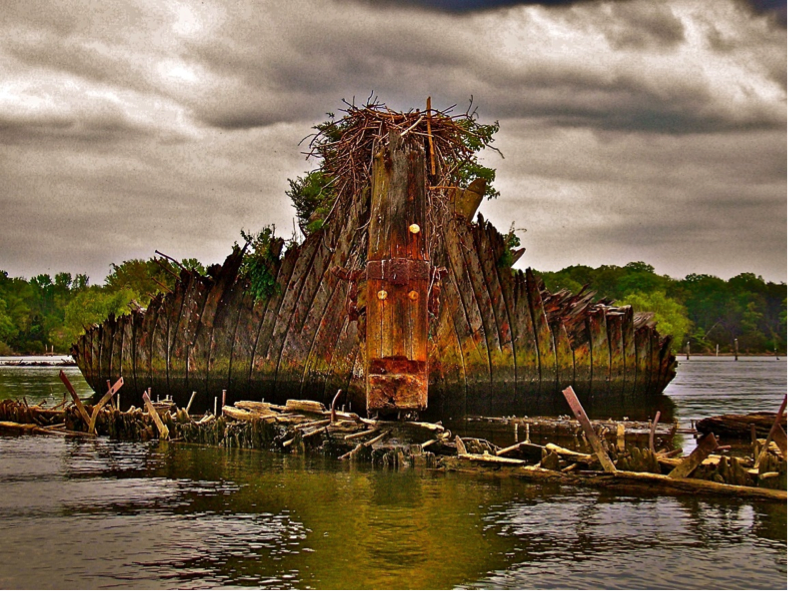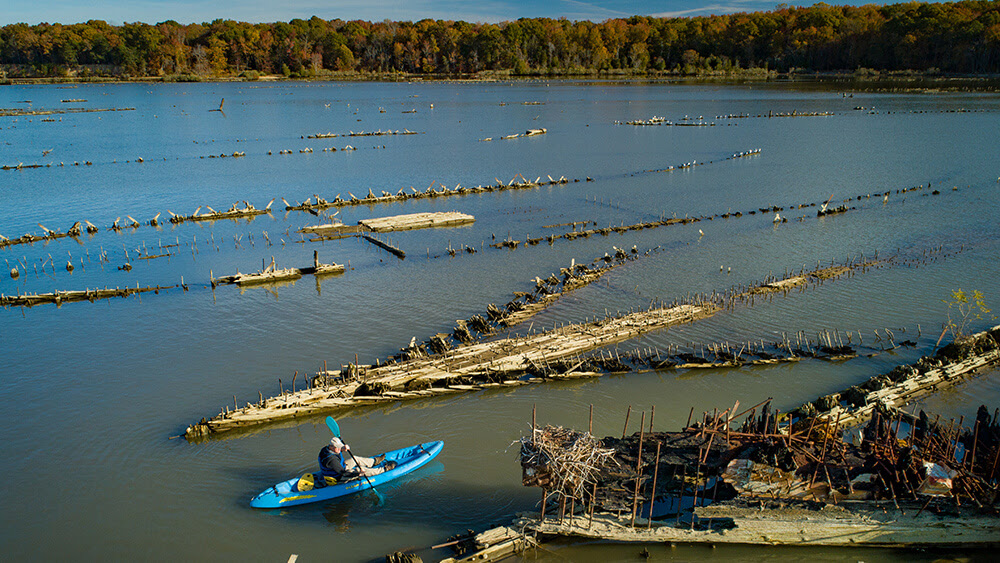Mallows Bay Ghost Fleet
(Photo Credit: Matt McIntosh/NOAA)
Written by Warren Brown
Preservation of the Ghost Fleet in Mallows Bay continues at full steam ahead. Experience the national marine sanctuary designation that became effective three years ago might offer some ideas for other special protected areas around the Bay:
Origins of the Ghost Fleet:
As WWI dragged on in 1917, hundreds of allied ships crossing the Atlantic Ocean were being lost to German submarines. When the United States entered the war, it pursued a dramatic initiative to replace a decimated merchant fleet by building steamships out of wood and building them in fantastically rapid time. Shipyards around the nation were set to work triple shifts and launched finished merchant ships ready for sea in as little as 30 days.
In 1918 Germany surrendered before any of the several hundred wooden ships built in such haste had reached a European port. Many of these ships continued service after the war delivering freight along the coast and across the Atlantic, but they were quickly recognized as obsolete and a burden to maintain.
One “solution” was to bring those ships to Mallows Bay on the Potomac River near Alexandria, Virginia, where they could be stripped of their metals and machinery for salvage. Research in the early 1990s began to document that Mallows Bay contained the largest and most varied collection of shipwrecks in the western hemisphere. In addition to the ships that were brought to the area of salvage, Mallows encompasses resources from the Revolutionary War, Civil War, and two World Wars, as well as generations of Potomac fishing industries, archeological resources dating back thousands of years and unusual wildlife habitat created by the slowly disintegrating ship hulls.

Public Access
(Photo Credit: Nick Zachar/NOAA)
Local Advocacy:
In September 2014, the governor of Maryland, acting on behalf of a coalition of community groups, submitted a nomination to NOAA seeking designation of Mallows Bay-Potomac River as a national marine sanctuary. Previous sanctuary designations had been “top-down” initiatives, and the proposal for Mallows Bay was considered one of the first to begin from the community.
An extensive public consultation process followed along with detailed analysis of social, environmental and economic impacts of the proposed designation. Various boundary configurations also were considered, and a draft management plan was prepared for public review. The nomination cited conservation goals to protect and conserve the fragile artifacts of the nation’s cultural heritage, as well as the opportunities to expand public access, recreation, tourism, research, and education to the area. The designation encompassing about 18 square miles of the tidal Potomac was approved in July 2019 but became effective on September 3, 2019 after a period of 45 legislative days for Congressional review.
Cooperative Management:
The final concept for the Marine Sanctuary recognized the importance of engaging partners in all aspects management and building a team with distinct areas of expertise. The state of Maryland continues to provide existing authorities for protection of the natural environment, including wildlife, fish, birds, water quality and habitat. The Maryland Historical Trust and the State Marine Archeological Program also address protection of historic resources. NOAA’s sanctuary regulations focus only on the protection of the shipwrecks and cultural heritage resources. NOAA is also providing education, science and interpretative programs that describe for visitors and user communities the relationship between the shipwreck structures and the natural environment. Charles County continues to provide for public access through the Mallows Bay Park that includes a boat ramp and other facilities on land leased from the state.
Results:
Moving from concept to designation may have seemed arduous as the process for consultation, analysis and review extended for more than four years. But the hope and promise for the sanctuary are being realized. Progress is being made to implement several action plans within the comprehensive plan approved along with the sanctuary designation. These plans cover resource protection, recreation and tourism, education, research, science and technology, and operations and administration. They emphasize “interpretive enforcement” to increase public awareness and compliance with measures to protect fragile resources.
Progress has been supported by the sanctuary advisory council that includes fifteen members and fifteen alternates, appointed by the Director of the Office of National Marine Sanctuaries. Council members represent education, maritime archaeology and history, research, fishing, recreation, tourism, cultural resources, economic development and the community at large. The council also has non voting representation for six government agencies, two Indian tribes and one Indian nation.
Visits to Mallows Bay Park increased about 35% between 2018 and 2019 and another 31% from 2019 to 2020. The Sanctuary has reached a wide audience through drone video tours that bring the sanctuary experience to viewers all around the nation. Partnerships also have engaged the surrounding communities. For example, scuba diving is being introduced at local schools by the National Association of Black Scuba Divers. University researchers are documenting the shipwrecks and producing 3D-printed models. “Dive with a Purpose,” an organization of retired military divers, has been documenting the shipwrecks and providing a baseline for understanding how the shipwrecks interact with the natural environment. Fishing, both commercial and recreational, continues in the Sanctuary under Maryland state regulations and concerns about new Federal fishing limits appear to have been put to rest.
A bio-blitz this year documented hundreds of species of plants and animals found in the sanctuary and helped engage community scientists to strengthen environmental stewardship. This includes embracing the motto: “take nothing but pictures, leave nothing but bubbles.”

Mallows Bay
(Photo Credit: National Marine Sanctuary Foundation)
Lightning Update is a regular communication of the Chesapeake Conservation Partnership. Any opinions expressed are those of the authors and do not necessarily reflect positions of the Partnership or member organizations.
To share a success story, news, or important event, send your information to:
Support for the Chesapeake Conservation Partnership is provided by:
National Park Service Chesapeake
EPA Chesapeake Bay Program
USDA Forest Service
Pennsylvania Department of Conservation & Natural Resources
Maryland Department of Natural Resources
Virginia Outdoors Foundation
US Fish & Wildlife Service
Chesapeake Conservancy
The Chesapeake Conservation Partnership is co-convened by:




